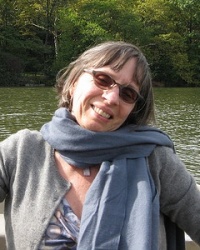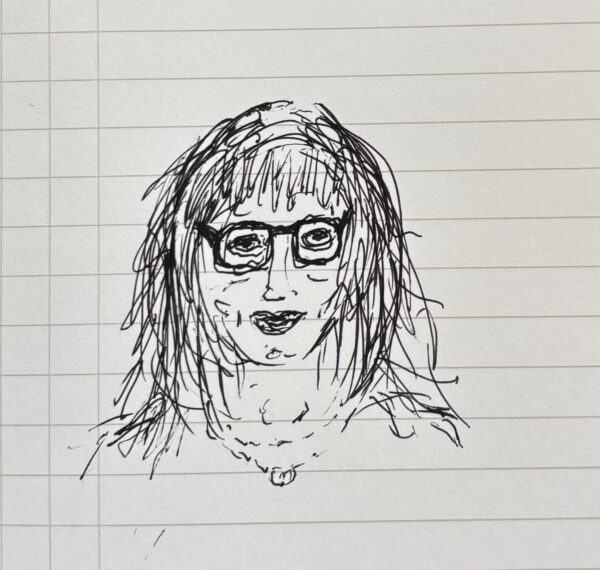
Laura Moriarty’s Which Walks, out now from Nightboat, confronts aging and its discontents with the old adage, “If you leave off you are lost.” Walking, and “witchiness” (“I’ve hosted a few covens,” she says below), become the means for Moriarty to probe compounding personal and political crises.
In our conversation we discuss the project’s origins and inspirations, from art criticism to archaeology, and the “other magics” of poetry.
—Daye Jung
Daye Jung: Within Which Walks are poems of intense attention to time, of the present and its echoes. When, where, and how did Which Walks begin?
Laura Moriarty: I began writing Which Walks before the pandemic. In fact, an early version of “Which Walk 1” appeared in Nathaniel Mackey’s magazine Hambone in 2019. It looks nothing like the later poems. The other pieces in that selection were not called “which walks” but many of the lines in those pieces were included in poems that eventually became Which Walks. Along with many other people, I experienced a lot of challenges during Covid, unrelated to the illness, though probably made worse by the extended lockdown. Also at that time, I gradually began an art practice, walked a lot, and when Mackey’s Double Trio came out, having preordered it, I got it in April, 2021 (a year into lockdown) and read all three volumes straight through with an obsessive attention. I was already very familiar with Mackey’s work but had tended a bit more toward the novels. But in that reading, I found I was dazzled and comforted by the poetry of this endless journey with its wondrous mythologies, prosodies, and mesmerizing music. Attending to my own work in the light of this experience, I decided to let my sense of Mackey’s work inspire my own. I began to write what I thought of as a continuous long poem with numbered pieces. The twolined form probably had more to do with my walking than with Mackey’s work and in fact my writing was not a copy of his style but a response to my love for the Double Trio and his many other books. I added indented stanzas, the single word lines I call “scatters,” and the prose sections (which I think of as memoirs of the present) to the mix. I figured my own half century of writing practice would mean that the work I did in this context would come out as entirely mine. Before that and since then I had and do occasionally still surrender to the influence of a writer or artist I admire, facing directly into the wild inspiring light of their thought rather than away from it.
Daye Jung: The poems that make up the book are composed in a continuous, meditative movement. Can you speak to how this movement is sustained through the acts of writing and walking?
Laura Moriarty: All my life I have really liked to keep moving. I made my living as a waitress for many years, just to keep out of offices, as well as, I imagined at the time, to keep my mind for my own work. This endless walking began as soon as I could go out on my own and continues to this day. I used to try to get lost in the woods of Cape Cod when I was very young. Currently, my usual daily routine is between 5 and 8 miles (for the other walkers out there), though I try to keep to 5 so I can get other things done. Reading is another obsession, and I am happy to be able to “read” audiobooks (crime & science fiction, climate stuff, art, history, politics etc.), as well as listen to podcasts and music while I walk. Often, I take phone shots of things I use in collages or to render in various ways. It’s exciting when I see a deer, snake, or coyote and lucky if I see a goldfinch or blue bird. So, the walking is very full of words and thoughts as opposed to meditation though, as a Buddhist, I do occasionally meditate.
Daye Jung: You write, “Her witchiness is not a choice but how she is seen by others. It is a strong, if vexed, position from which to work and see.” Could you expand on this position and its potential?
Laura Moriarty: “Witch” can be a positive word for a, usually, older woman who is wise and caring and maybe knows about herbs or other magics. That’s the good version, but, just as often one can be seen as a threatening, cranky old hag or, even more likely, not seen at all. Ageism, sexism, ableism and any other bigotry that might apply to oneself are very present these days despite years of efforts and some success with those. Also, we older ones can be regarded as “cute” (we hate that). For me the freedom that has come with being older has been well worth the precarity which does increase as you age. It’s not only the freedom of being retired but the tendency not to give that much of a fuck what people might think or say, “witch” or whatever, which is truly a great relief.
The power that some people have to inspire, help, and occasionally even unnerve others is something I’ve often observed and, maybe, practiced a bit. I’ve hosted a few covens and somehow know a lot about tarot, astrology, alchemy, and other such practices though I firmly think of myself as not being superstitious.
Daye Jung: In “the case” your poetic past returns: “‘I get stronger as I get older,’ she wrote as a young woman. ‘But never strong enough.’” You reread the long poems of your youth, works by H.D., William Carlos Williams, Louis Zukofsky, Robert Duncan, Kamau Brathwaite, Susan Howe, Beverly Dahlen, Rachel Blau DuPlessis, M. NourbeSe Philip, and Nathaniel Mackey. What insights do these poems, and the processes of rereading, offer you now?
Laura Moriarty: Works by the writers mentioned in the Which Walks “prologue” have informed my own for a long time. The Case is the name of an earlier book of mine and there are several titles of and quotes from my other books in Which Walks. It is part of the “memoir of the present” thinking that informs this book and much of my recent writing. The list above has to do with the idea of the long poem and I relooked at these writers as I was composing Which Walks. But I could make a similar, even longer, list of different writers who have also been important to me. A few in the present list are people I know or knew. Jack Spicer should have been in there as he is the writer I quote the most in the book. To be honest, my “long poem” resembles his sense of the serial poem more than it does the lifelong poems of many of the writers I mention.
I read deeply and endlessly and have a whole lot of books on hand and don’t seem to be able to stop myself from getting more all the time. I am constantly reading philosophy, literary and art criticism, archaeology, physics, cognitive science, astronomy, history, etc. Spending the morning in such reading—taking note of material that might end up in a poem and then actually writing a page or two of that poetry is one of my ideas of paradise.
Daye Jung: How does Which Walks relate to your visual art making process?
Laura Moriarty: As I’ve written in the introduction to the book and elsewhere, my new visual art practice, aging, and walking are the main subjects of Which Walks. I like imposing limits on a project—of form, subject matter, kinds of material included and other considerations. I enjoy pushing against those limits, doing as much as I can within them, and then focusing on something else in the next project.
Doing the art has been fascinating because it is a new experience for me to think with my hands. In relation to that, I will say that I have often engaged in personal, very physical research for my other books. I visited many volcanoes in writing Personal Volcano and don’t get me started about the romantic books of my youth. (It’s funny to write a love poem about someone you’re refusing to see because you want some time to write.)
The iterative, searching part of art making is not unlike writing but involves more physical movement and other senses. For example, sight is involved in a way that is not reading, though it is not unrelated. Touch is intensely involved, of course, especially in sculpture, but then, when I think of it, especially in all the media I do. I often come to the end of my strength in making or installing work and wish I had started this practice when I was younger (though I wouldn’t have had the time for it then). I have constantly found that it is not possible for me to know what to do except by doing it. This is true of writing as well, but in writing I seem to know a lot more about what I can do and how it might come out. The fact that I am new at this visual practice makes it harder, more surprising, and, at times, more compelling than writing. I love that colors and textures are involved, that the figures seem real and look back at me with their empty eyes.

Making art has caused me to be even more interested in seeing it in galleries, museums, and books than I have always been. I tend to be enthusiastic about everything with the innocent zeal of the young (which I very much didn’t have as an opinionated young person) despite being a septuagenarian.
Several of the poems in Which Walks are written in homage to artists I admire. One I studied with, Carlos Villa. Another, Stanley Whitney, is the dear friend of my dear friend, Norma Cole (who curated my last show at the gallery Right Window, and whose artwork has always been important to me). In an interview, Whitney made a comment I use to end the poem about his work: “I could put color next to color and not lose the air.” I love this idea because “air” in a poem has always been the thing I most look for— wanting not to be closed in by work that I find over or under written. I like some space to think. I used to call this “emptiness” and edited an issue of my old on-line journal non on the subject. (There is a link to non on my site in the Bibliography section under “Edited”). Now, because of my walking, drawing, bending wire, writing, and aging, I often think of lines. I’ll end this interview with some lines from a prose piece in Which Walks called “future present:” “The old woman is older still . . . She makes lines in the shape of her head . . . Her walking satisfies her longing to get to that next place. The lines produced by this movement are the same as her fate. Her face.”

See more on Laura’s site here.
